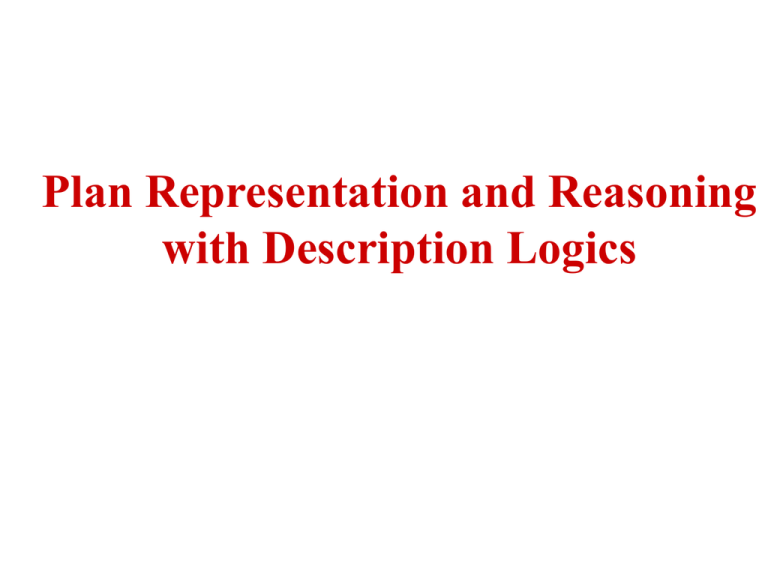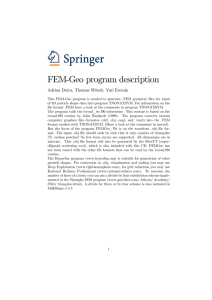Plan Representation and Reasoning with Description Logics
advertisement

Plan Representation and Reasoning with Description Logics Representing Planning Knowledge in Description Logics: Overview • Action taxonomies in CLASP – extended language to represent action networks • Plan taxonomies in SUDO-PLANNER – plan subsumption of partially ordered plans • Goal taxonomies in EXPECT – expressive representations of goals and their parameters These systems can exploit the descriptions of all the objects in the domain (domain knowledge) in order to reason about action, goal, and plan descriptions Defining Actions, States and Plans in CLASP in a Telephony Domain (DEFINE-CONCEPT System-Act (AND Action (ALL ACTOR System-Agent))) (DEFINE-CONCEPT Connect-Dialtone-Act (AND System-Act (ALL PRECONDITION (AND Off-Hook-State Idle-State)) (All Add-LIST Dialtone-State) (ALL DELETE-LIST Idle-State (ALL GOAL (AND Off-Hook-State Dialtone-State)))) (DEFINE-CONCEPT Callee-Off-Hook-State (PRIMITIVE State)) (DEFINE-CONCEPT Callee-On-Hook-State (PRIMITIVE State)) (DEFINE-CONCEPT Callee-Off-Caller-On-State (AND Callee-Off-Hook-State Caller-On-Hook-State)) (DEFINE-PLAN Pots-Plan (AND Plan (ALL PLAN-EXPRESSION (SEQUENCE (SUBPLAN Originate-And-Dial-Plan) (TEST (Callee-On-Hook-State (SUBPLAN Terminate-Plan)) (Callee-Off-Hook-State (SEQUENCE Non-Terminate-Act Caller-On-Hook-Act Disconnect Act))))))) (DEFINE-PLAN Originate-And-Dial-Plan (AND Plan (ALL PLAN-EXPRESSION (SEQUENCE Caller-Off-Hook-Act Connect-Dialtone-Act Dial-Digits-Act)))) Plan Representation and Subsumption in SUDO-PLANNER • Plan is described as a set of action types associated with identifiers – [(surgery, id1) (CABG, id2)] • Plan is simplified if action subsumption and same id – [(surgery, id1) (CABG, id1)] -> [(surgery, id1)] • Plan subsumption – Action network viewed as bipartite graph matching P a1 a2 a5 R a1 a4 a5 Q a3 a4 a6 S a2 a3 a6 • Matching Goals in EXPECT Desired goals and available capabilities are automatically translated to LOOM concepts • Classifier is used to find most specific method OBJ capability that subsumes the posted goal Method capability: (move (OBJ (inst-of cargo)) move (WITH (inst-of aircraft))) Goal: (move (OBJ (inst-of cargo)) (WITH C-140)) OBJ move OBJ move cargo cargo WITH vehicle WITH aircraft cargo WITH C-140 Self-organizing method taxonomy OBJ move cargo WITH truck Reactive Systems Yolanda Gil CS 541, Fall 2003 (Thanks to Karen Myers from SRI International) Summary • Control systems – Networks of “variables” (arcs) and “functions” (nodes) • Reactive Action Packages (RAPs) – Networks of “conditions” and “tasks” • Task Control Architecture (TCA) – Network arranged according to “vertical capabilities” • Procedural Reasoning System (PRS) – Integrates planning, BDI, and reactive techniques • Anytime algorithms – When time is short, managing what you think about • Learning and uncertainty reasoning PRS Interpreter Execution Cycle 1. New information arrives that updates facts and/or tasks 2. Acts are triggered by new facts or tasks 3. A triggered Act is intended 4. An intended Act is selected 5. That intention is activated 6. An action is performed 7. New facts or tasks are posted 8. Intentions are updated New Facts & Tasks 2 (overpressurized fuel-tank) 7 (ACHIEVE (position ox-valve closed)) Act Library 1 ACT2 Cue: (TEST (overpressurized tank.1)) Act Execution External World Facts & Tasks 6 8 5 (ACHIEVE (position ox-valve closed)) ACT1 current 4 ACT1 Cue: (ACHIEVE (position valve.1 closed)) Goal2 ACT8 sleeping Fact1 ACT2 normal Intention Graph Goal3 ACT3 sleeping 3 Distributed and Multi-Agent Planning Issues • • • • • • • • Who is in charge? How distributed? How much info is shared? Who benefits? What and how to communicate? How and how much to coordinate? Can tasks/goals/resources be negotiated? How to handle execution dynamics? Summary (I) 1. Task sharing – – Homogeneous agents Heterogeneous agents • Contract nets – – • 2. Contactors bid Managers bid Market mechanisms Results sharing – – – Blackboard architectures Distributed constraint satisfaction Resource sharing through auctions Summary (II) 3. Distributed planning – Planning approaches • • • • – Execution issues • • 4. Post-planning Pre-planning Mental state and collaboration – – 5. Cooperative plan Construction Centralized planning for Distributed plans Distributed planning for Centralized plans Distributed planning for Distributed plans Joint intentions SharedPlans Coordination without communication Mixed-Initiative Planning Challenges • Interpreting user input – Mapping into possible operations/responses – Disambiguating requests • Intelligent search – Managing classes of solutions – Tracking constraints and previously explored solutions • Facilitating user’s cognitive task – Grounding the discussion with a specific plan • Acting on the user’s input – Flexible planning framework that can support collaboration Recap and Summary • Dialogue issues in mixed-initiative planning: TRAINS – Interpreting user input, disambiguation – Plan representation as goals/tasks/resources/state + straw plan – Hybrid planning architecture • Integrating user guidance with a planning algorithm: PASSAT – Incorporating the user’s input into a plan generation algorithm




